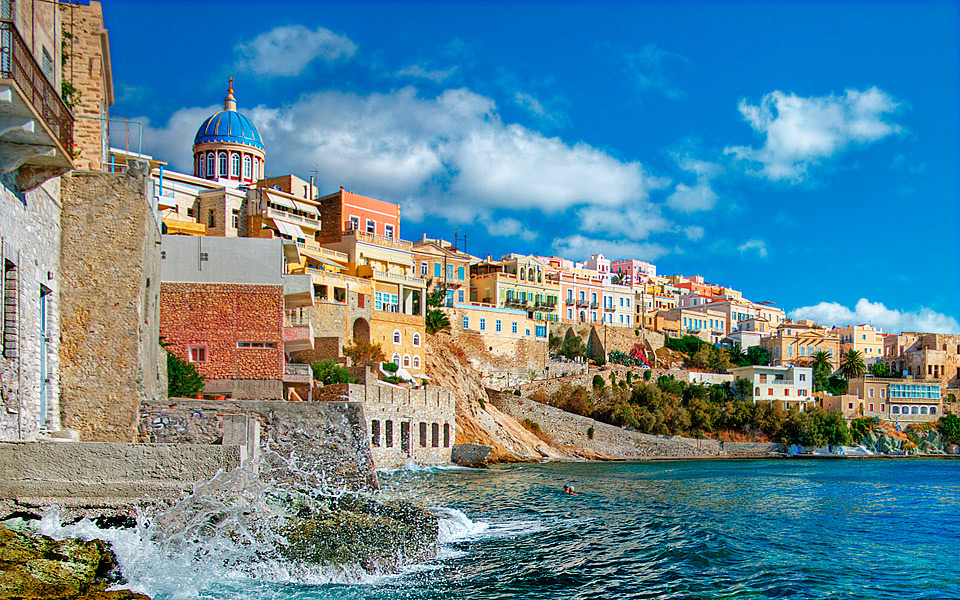Strolling around Ermoupoli, the capital of Syros as well as the Cyclades, it is difficult to believe that this city is still less than two centuries old. Ermoupoli was founded as a result of the Ottoman-inflicted devastation of Chios in 1822, as well as persecutions of the locals on Samos, in Smyrni, Kydonies, Rhodes, Psara and Kasos. The resulting urban miracle at the foot of the Ano Syros hill, previously home to just a handful of humble homes and warehouses, is impressive.
Rich neoclassical buildings with marble fittings, stunning mansions with imposing pediments, and stately houses with ornate corbels, all true works of art, went on to adorn Ermoupoli, whose population had exceeded 14,000 as early as 1828 to become Greece’s biggest urban center at the time. Industrialists, merchants, bankers and ship owners constituted a significant part of the city, offering countless neoclassical buildings that have established the place as a living museum.
At the same time, affluent and cultivated citizens of Ermoupoli also provided the city with cultural magnificence that was unprecedented for its time, as conveyed by buildings such as the historic 1st Ermoupoli high school (Gymnasio) ‒ newly liberated modern Greece’s first to operate, in 1833, with Neofytos Vamvas, one of the period’s most prominent scholars, as its principle ‒ the Apollon Theater; and the Town Hall at Miaouli square.
“Rich neoclassical buildings with marble fittings, stunning mansions with imposing pediments, and stately houses with ornate corbels, all true works of art, went on to adorn Ermoupoli”
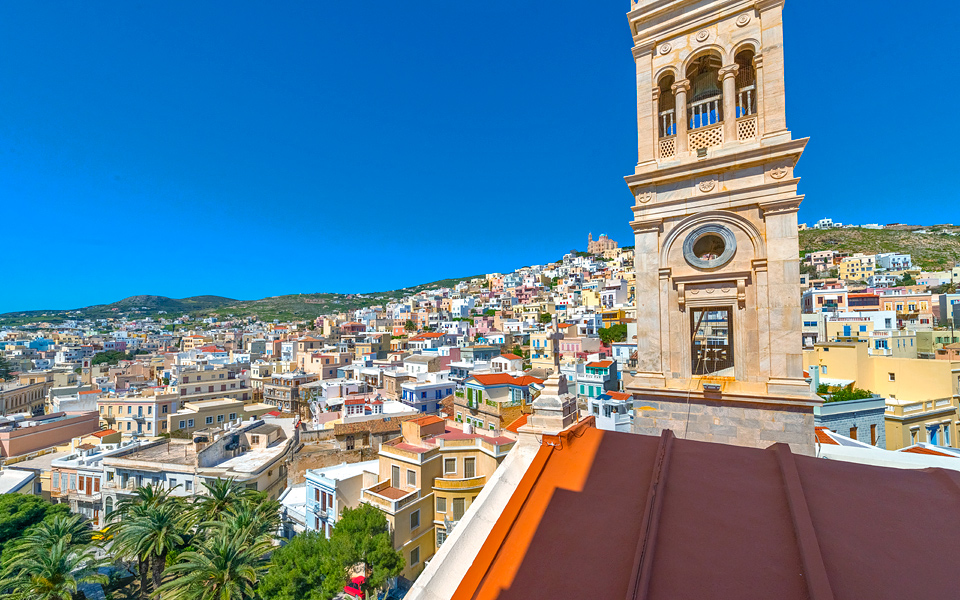
“Ermoupoli, a place where we encounter the largest concentration of neoclassical buildings, unaffected by any external intervention and carrying romantic neoclassical character, radiates sweetness, grace and measure. The buildings are divided in categories, beginning with those associated with the financially prominent. Marble and marble decorations dominate the facades, while their interiors are exquisite, with ornamented ceilings, marble stairways and patios.
“The middle-class buildings, simpler yet still elaborate, feature less marble and detailed masonry, which is also the case with working-class homes, often featuring eastern influences. They all constitute an entirety of living cells, which, when encountered, visited, or restored, make you feel as if you are conceivably engaged with their original owners, prompt you to imagine their celebrations and daily lives, and sense the anxieties felt by the original craftsmen when these structures were being created. The restoration of any of these buildings offers us a wealth of knowledge on technique and aesthetic texture,” noted architect Giorgos Evripiotis. “More recently, demand has been created for purchases of small neoclassical buildings by individuals impressed by the urban wealth and continual vitality of the place.” he added.
“More recently, demand has been created for purchases of small neoclassical buildings by individuals impressed by the urban wealth and continual vitality of the place”
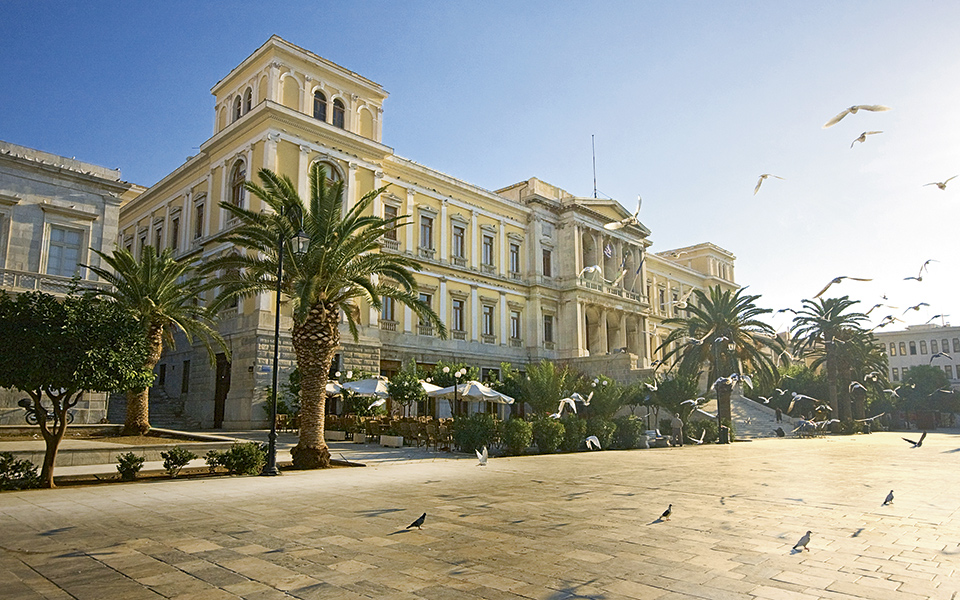
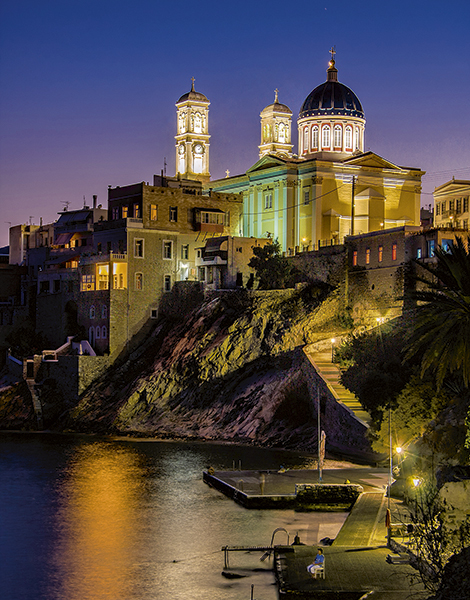
© Yiannis Larios
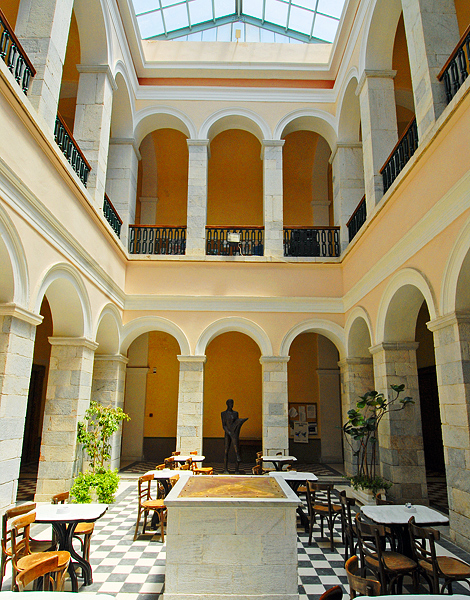
Entering the city’s historic buildings
The Ermoupoli Town Hall, one of the biggest in Greece, is regarded by some as the city’s most striking building. It was designed by German architect Ernst Ziller. Construction of the project began in 1876 and was completed in 1898. Dimitris Vafiadakis, the mayor at the time, is honored with his name on the historical inscription below the marble facade’s pediment as well as by an imposing bust in the building’s foyer.
Just meters away, the municipal Apollon Theater, symbolizing the cultural development of Ermoupoli, was designed by the architect Pietro Sampô and built between 1862 and 1864, when it was launched with a production of the opera “Rigoletto” by Guiseppe Verdi. The European specifications, featuring three rows of wooden loges and a gallery, provide abundant splendor to the building’s interior. The theater’s architectural design was influenced by Italian examples such as the La Scala opera house in Milan, the restored San Carlo Theater in Naples, as well as Florence’s Castelfranco and Teatro della Pergola. The extraordinary ceiling paintings depicting poets and composers were created by Dimitris Fortsas during renovation work conducted on the building in 1998.
The Cyclades Workers and Employees Center, widely known as the Anagnostopoulos or Velissaropoulos building, is located just a few steps away. This exceptional all-marble building, one of the most impressive to be seen in Ermoupoli, was constructed between 1871 and 1873 and designed by the architect Ioannis Vlysidis.
Looking upwards, the majestic Aghios Nikolaos church may be seen between the pines and palm trees at the square. Heading up the hill towards the church, the grand former residence of Nikolaos Prasakakis, mayor of Ermoupoli for two terms, one between 1837 and 1840, the other from 1848 to 1850, is situated to the side, just before passing the church. This building, which nowadays houses the Cyclades Chamber of Commerce, stands as an exemplary urban mansion.
“The municipal Apollon Theater, symbolizing the cultural development of Ermoupoli, was designed by the architect Pietro Sampô and built between 1862 and 1864”
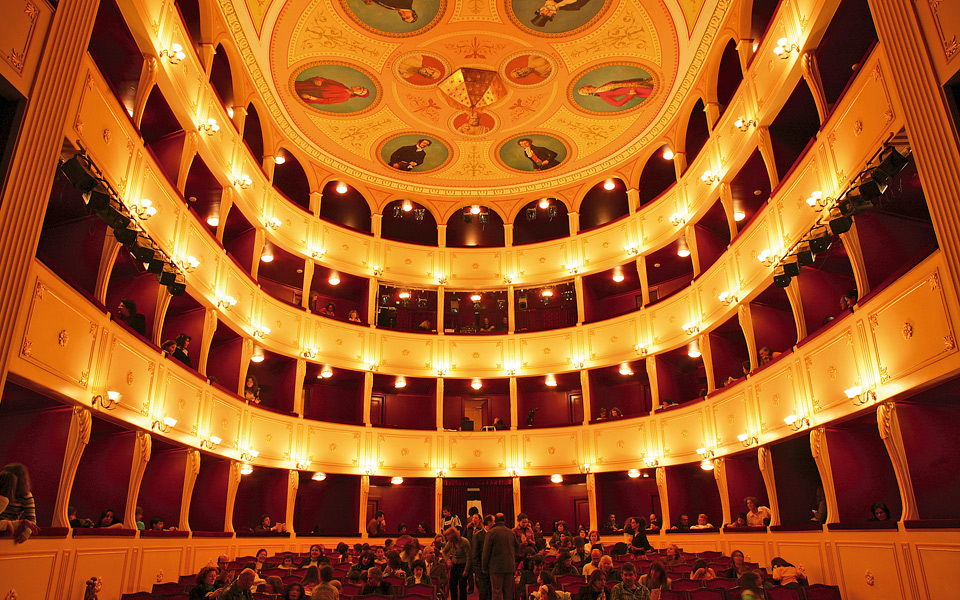
The first neoclassical building to be built in modern Greece, its exterior design is almost Doric in line. Designed by German architect Johann B. Erlacher and built between 1834 and 1836, its magnificence is more apparent on the inside which was recently restored. It features marble floors and staircase, vast spaces, high-ceilinged rooms, and rich murals dating back to 1836. Portraits of Greek War of Independence heroes, including Ioannis Kapodistrias, modern Greece’s first governor, with whom the building’s original owner had collaborated, feature at the entrance hall on the first floor.
Crossing Appolonos Street leads to Tsiropina Square, where the Prefecture building (Nomarhio) is located. It originally served as the residence of Chios native Konstantinos Tsiropinas, mayor of Ermoupoli between 1887 and 1895. This mansion, the foundations of which were laid over rocks, was built over two years, in 1883 and 1884, with contractor Georgios Grekas at the helm of the project. It features an Ionian propylea, or monumental gateway, pilasters bearing Corinthian columns and female statues on the parapet.
Other worthwhile buildings open to the public include the former residence of prominent Chios merchant Ioannis Zygomallas, built in 1880 and nowadays housing the power utility PPC’s headquarters on the island; an interesting building on Georgiou Souri Street, which nowadays is shared by the Lyceum of Greek Women (Likio Elllinidon) and the Hellas Club (Leschi Hellas); and other imposing buildings along Kalomenopoulou Street, beginning from Tsiropina Square, such as the cathedral and National Bank of Greece (Ethniki Trapeza) buildings. Finally, pay a visit to the newly arrived Folklore (Laografiko) Museum, housed at a mansion that served as the residence of the Rethymnis shipping family, originally from Kasos.

